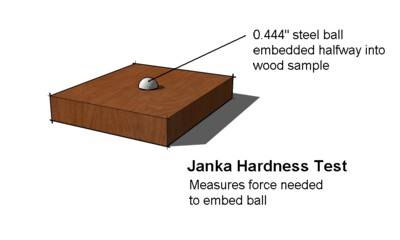What Does The Janka Hardness Rating Mean?
The Janka hardness test is the international standard for measuring the resistance of a sample of wood to denting and wear.
It's expressed in psi, or pounds-per-square-inch. The test measures the pressure required to embed an 11.28mm (.444 in) diameter steel ball into wood to half the ball's diameter. The measurement was developed to determine whether a species is suitable for use as flooring; however, we include it here and compare it to the rating of red oak to help you make a buying choice.
There is a difference between hardness and being difficult to work with. Generally speaking, the harder the wood the easier it is to finish and polish. Harder woods create good, solid long-lasting joinery in furniture.
The hardness of wood varies with the direction of the wood grain, and varies from piece to piece. So a Janka rating is an average of numerous tests performed on all directions and numerous pieces. Use the Janka hardness rating as guide, not a definitive answer.

Image by Nasa-verve, Wikimedia Commons
What Does Specific Gravity Mean?
Specific gravity is the ratio of the density of wood to the density of water.
A wood doesn't float, for example, if it's specific gravity is 1.00 or greater.
We display the specific gravity for each of our woods using it's kiln-dried measurement (instead of the non-dried measurement).
It's Just a Guide
The trouble with this number is that the specific gravity of a wood changes with its moisture content. So use this number just as a ballpark guide to estimate how dense a wood is. We've also compared the number to that of red oak, as red oak is the most commonly used hardwood in North America.
Why Does It Matter To You?
Most of the time, the higher the specific gravity, the more abuse your tools take. Conversely, woods with low specific gravity don't make good choices for furniture and are more difficult to create nice, strong joints with.
Just use this as a guide to help you make an informed choice.



